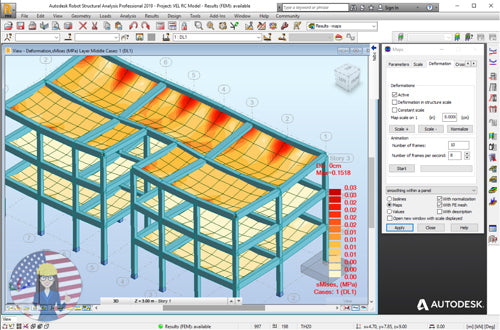Repair of Structures Damaged by Earthquakes
The repair of a building damaged by an earthquake starts from a correct analysis of the damage. The only visual evaluation of an expert is not enough, since the structure must be understood as a structural assembly that must withstand the seismic accelerations of the next event as indicated by the regulations and the current code.


It is in these cases when structural analysis and design programs such as Robot SAP allow to pose the original structure and submit to the accelerations of the earthquake that damaged the structures to analyze their behavior and detect hidden faults.
Analyzing an existing structure is difficult, as some damage may be hidden by layers of finishes.
Others may be due to overloads that were removed at the time of the inspection and still, others may be due to the impact of neighboring structures in the vicinity by the earthquake. An extremely important part of the approach to the structure to be studied is the type of terrain where the building stands.


The foundation and how the building has been laid must be carefully studied.
Differential settlements in the structure, different from those projected, can explain many catastrophes. Some are due to inadvertent underground structures, such as the remains of pilings from a previously demolished building, others to changes in the water table, failures in urban networks, or even deep neighboring excavations when pumping groundwater.
Autodesk Robot Structural Analysis Professional allows this entire scenario to be carefully posed in the analytical model to allow it to be studied and to explain the cause of the damage.
But even detecting differences in behavior between the analytical model and reality allows us to refine our study model and better understand the behavior of the structure. The next step is to propose the damaged analytical model.


Autodesk Robot Structural Analysis Professional allows from the cancellation of the element, slabs, beams or columns, to the decrease of its structural qualities. The study of this affected analytical model allows us to locate the critical areas that must be reinforced.
But also detect that the reinforcements do not induce adverse effects such as twisting or deformation in another part of the structure. Solutions such as the installation of cutting elements, in concrete or steel, walls or spreaders, change the behavior of the analytical model in the program, reducing deformations.
Solutions such as the increase in the section of beams and columns employing shotcrete can also be raised and their behavior shown by the program during the deformation and vibration analysis.


Autodesk Robot Structural Analysis Professional uses the Newmark-Hall method to construct an elastic design spectrum from soil type and maximum soil accelerations, velocities, and displacements.
In combination with the Unit Price Analysis program, it is possible to decide if the reconstruction or reinforcement of a structure is economically viable with the complete replacement of the structure.


